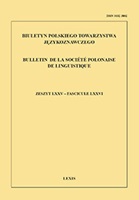Towards a Construction Grammar Analysis of English Pseudo-Copular Constructions with Perceptual Impression Verbs
Towards a Construction Grammar Analysis of English Pseudo-Copular Constructions with Perceptual Impression Verbs
Author(s): Zbigniew KopećSubject(s): Morphology, Syntax, Descriptive linguistics
Published by: Polskie Towarzystwo Językoznawcze
Keywords: copula, semi-copula; pseudo-copula; (semi-)copular construction; pseudo-copular construction; perceptual impression verb; evidential modality; epistemic modality;
Summary/Abstract: Be as a copula in English, traditionally part of the subject-verb-subject complement pattern, syntactically links the subject to a complement and semantically makes little or no contribution of its own to the meaning of the clause. Semi-copulas (e.g. become, grow, turn, remain, etc.) share a number of properties with the be copula, but differ from it in that they cannot be left out without resulting in ungrammaticality or changing the meaning of the construction. They are introduced as the expression of ingressive or continuative aspect. Pseudo-copulas including perceptual impression verbs such as sound, look, taste, smell, and feel do not really link the subject to a complement. Their meanings are evidential and evaluative, based either on the speaker’s sensory modality or reported modality. The author provides descriptions of five pseudo-copular constructions with perceptual impression verbs, based on the Construction Grammar approach, but derives insights and their names from Functional Grammar (Hengeveld 1992) and Word Grammar (Gisborne 2010.
Journal: Biuletyn Polskiego Towarzystwa Językoznawczego
- Issue Year: LXXVI/2020
- Issue No: 76
- Page Range: 321-325
- Page Count: 15
- Language: English

